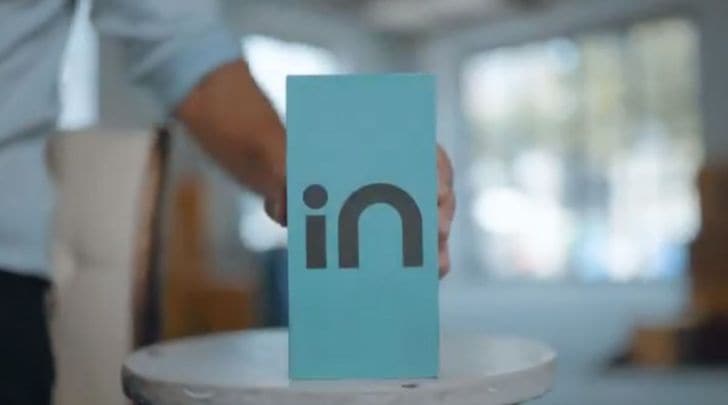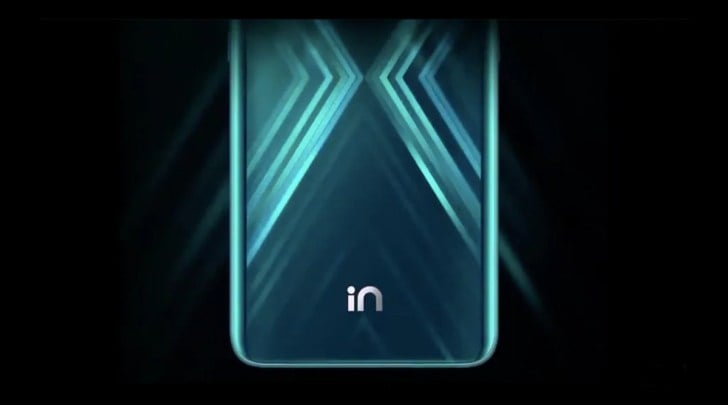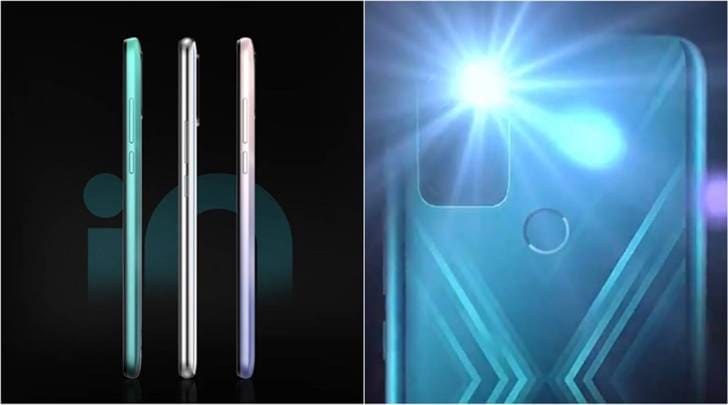 Micromax is gearing up for the launch of its new IN series. In this screenshot, Rahul Sharma, co-founder of Micromax, talks about the return of the brand. (Image via YouTube)
Micromax is gearing up for the launch of its new IN series. In this screenshot, Rahul Sharma, co-founder of Micromax, talks about the return of the brand. (Image via YouTube) “Namaskar mera naam Rahul Sharma hai. Ek middle class family main janam hua. Papa ek sarkari school main teacher the…. Mujhe yaad hai badi jhijak ke saath papa se 3 lakh rupaiya udhaar liye the…” (Hello my name is Rahul Sharma. I was born in a middle class family. My father was a government school teacher. I remember borrowing 3 lakhs rupees from my father with great hesitation when I wanted to start the company.)
This is the opening line of Micromax’s advertisement as it makes its comeback pitch in the Indian market. In front of the camera is Rahul Sharma, the most recognised of Micromax’s four co-founders, long seen as the face of the brand. He founded the mobile brand with Rajesh Agarwal, Vikas Jain and Sumeet Kumar. Incidentally, Jain is gearing up to launch a new brand of his own focused on fitness and wearables under the World of Play brand.
Sharma then goes on to talk about how Micromax became a big success in India, though it was eventually beaten by the Chinese (cue sad music). But he then adds, ‘Border par jo hua, woh theek nahi hua,’ (what happened at the border was not right) a clear reference to the Galwan Valley clashes between the Indian and Chinese forces.
It is an emotional pitch, interspersed with a clear tug of nationalism and patriotism, one that Micromax is hoping will make it stand out and perhaps appeal to the Indian consumer as it gears for a comeback tomorrow with a new ‘IN’ series of smartphones.
 In the video, Sharma makes a patriotic appeal around Micromax and its return.
In the video, Sharma makes a patriotic appeal around Micromax and its return.
But the anti-China sentiment can only take it so far. “We’ve always believed as analysts that this (anti-China) is a temporary kind of thing. For the consumer, it is about value, he sees the value and Chinese players have been giving the value. They (Micromax) have to match them (Chinese) in terms of product portfolio, in the specification versus price equation, in terms of investment, in marketing, retail marketing, online player distribution. If they’re not able to do that, they will just fizzle out,” Navkendar Singh, Research Director with International Data Corporation (IDC) India tells indianexpress.com over a call.
In fact, IDC’s own dipstick survey in June-July, done at a time when the Galwan incident just happened, showed that while seven out of ten consumers were walking in a store asking for a non-Chinese phone, only two or three out of them were walking away with a non-Chinese brand. The reason: the number of non-Chinese options are limited in the market. There’s Apple which is not exactly affordable for everyone and then Samsung which offers a wider choice in terms of pricing.
Rushabh Doshi, Research Director at Singapore-based Canalys Research says the messaging is timed perfectly. “They are riding on the anti-Chinese sentiment, which is to some extent an emotional reaction. But let’s not forget that Micromax lost to the Chinese vendors because of the quality and after sales services. They were relying on the Chinese supply chain. The only way they can make it if they have a strong intellectual property which can rival Chinese vendors,” he tells indianexpress.com in a telephone conversation.
 The IN brand will mark Micromax’s return to the smartphone world.
The IN brand will mark Micromax’s return to the smartphone world.
A new opportunity?
But given the state of the Indian smartphone market, with the top five players accounting for more than 80 per cent of the market, is there really space for a Micromax, keeping the nationalistic pitch aside?
“A space can be made. We’ve seen Realme make space for itself and doing very well in the past two years,” Singh reminds us. But he points out that the top five brands, and which includes Realme now, are getting bigger and pushing out the smaller brands like Nokia, Motorola and LG.
“If Micromax sticks to the Rs 7000 to Rs 10,000 segment, and doesn’t fight the brutal fight of Rs 10,000 to 20,000 where everyone is present, that might work in their favour. We have seen in the past nine months, thanks to budget constraints, people are going for sub-Rs 10,000 phones. So that’s a space Micromax can fill,” Singh notes. He adds that while there are brands under Rs 10,000, it is dominated by ITEL, Tecno and some Realme and Redmi. It is also a low margin game in this segment and not everyone is profitable.
Sharma has been quoted as saying that the focus of the brand will be on the Rs 7,000 to Rs 15,000 price segment. Phones in the range of Rs 20,000 to Rs 30,000 are likely to make an appearance later on. The November 3 launch is expected to focus on the more budget friendly options.
According to Tarun Pathak, Associate Director at Counterpoint Research, says “everything will depend on the first product.” He too points out that with the pandemic a lot of users have tight budgets though there is a growing need for smartphones. For instance, Pathak says, the new online education opportunity could help Micromax.
“All they need to do is launch a product, which makes sense in price. A lot of people did not increase their budget in this pandemic. The $100 to $150 segment now has more people relying on that particular segment, which can work to their favour,” Pathak adds.
 Micromax IN series launch: Sharma has promised good quality specifications and a stylish design.
Micromax IN series launch: Sharma has promised good quality specifications and a stylish design.
Doshi agrees, but also want Micromax to answer who its target audience is. “If the target audience is the ultra-patriotic who wants to own an Indian brand, Micromax will offer that, at least on paper. But still the components will be similar to the Chinese,” he notes. The question in his view is how will Micromax build this market, and sustain its shipments in this overcrowded segment with what is clearly a short-term opportunity.
Stock Android, Doshi says, will offer a clean performance, but will also lack localisation. After all the skins from Xiaomi, Oppo, vivo, have a lot of localised features which do help users, he points out. In his view, Micromax won’t be able to control user experience if they go for Stock Android.
Micromax will have to also compete in the ever-growing, but highly competitive, online segment. “In online you have to churn out products very frequently and be on top of things. In online and entry-level, people keep comparing specifications,” Pathak states. In his view, it will be crucial for Micromax to find a niche on the product side.
According to Singh, Micromax has good relative brand value in the under Rs 10,000 segment and in the tier-2, tier 3 market. “They have been doing feature phones for a while, with low-cost smartphones. There’s a strong residual brand value there, and people have probably bought a Micromax phone in the past. So in that way it could be a clever move,” he said.
But as Doshi cautions, Micromax now faces competition with big pockets, which has a lot of money to spend, especially when it comes to branding and advertising. They will have to be quick in rebuilding that brand presence. Micromax has also lost their earlier advantage of the vast distribution network, especially in the offline retail market to the Chinese incumbents. The Micromax boards which used to be a regular sight in moffusil markets have now been replaced by the Oppos and Vivos.
 Micromax co-founder Rahul Sharma in multiple interviews has said that the devices in the new series will be priced between Rs 7,000 to Rs 15,000. (Image: Micromax)
Micromax co-founder Rahul Sharma in multiple interviews has said that the devices in the new series will be priced between Rs 7,000 to Rs 15,000. (Image: Micromax)
When Micromax was king
But the Indian market wasn’t like this just a few years back, and Micromax was a leading player. In 2013, Micromax was the first player to bring a smartphone with an HD display (720p resolution) at a price of under Rs 15,000 called the Canvas HD and it was a big deal. It was the first phone to offer an HD display at such an ‘affordable price’, and came with specifications which might seem very humble today.
A big 5-inch screen, yes at one time a 5-inch screen was considered big, a quad-core processor and 8GB on-board storage. All specifications that made the Canvas HD a huge hit when it first launched. In 2013, Micromax also signed on Hugh Jackman as its brand ambassador, a move that boosted the image of the brand.
In 2014, Micromax was the largest mobile phone supplier with a 16 per cent share (for both smartphones and feature phones combined) and even expanded into Russia, a sign of its growing global ambitions. That year it also launched a sub-brand, YU Televentures, which had a phone called Yutopia, a potential OnePlus challenger with a Snapdragon 810 processor and CyanogenMod OS 12 on Android 5.1.1. In 2015, it had beaten Samsung to take the top position in the Indian smartphone market with a 22% market share.
But by the third quarter of 2016, things had changed drastically. IDC’s data showed that Micromax was down to third position, beaten by Samsung and Lenovo Group, its shipments declining in double digits. By 2017, Micromax was no longer in the top five vendors in India’s smartphone market.
Cut to 2020, the Indian smartphone market has changed drastically. It is dominated by Chinese players like Xiaomi, Realme, vivo and Oppo with Samsung still managing to hold fort. Indian names like Micromax, Lava, Karbonn, which once had a majority share are nowhere to be found.
 Micromax will mark its comeback in Indian smartphone market with two new phones (Source: Micromax/Twitter)
Micromax will mark its comeback in Indian smartphone market with two new phones (Source: Micromax/Twitter)
And it seems Sharma knows the challenges ahead for his once-dominant brand. “Completely performance-oriented products. Gamer-oriented products. Humko bada responsibly aana hai,” Micromax co-founder Rahul Sharma tells Gaurav Choudhary, better known as ‘Technical Guruji,’ in an interview. The decision to speak to a Hindi YouTuber a clear indication of the target audience he has in mind.
In his interview, Sharma also appears to be taking on the charge that has long been added to Indian smartphone companies: That they were merely rebranding Chinese phones and selling them in India. “Sab kuch hindustan mein banate hain,” he explains, listing the brand’s past achievements.
Micromax has also been granted the Production Linked Incentive Scheme (PLI) approval, which will give it a 4 to 6 per cent saving on incremental sales. But as Singh points, out unless Micromax gets the volumes and is able to push exports, PLI won’t help much.
But will all this be enough for Micromax to succeed? “They need to sort out their internal goals. What exactly are they going to do? It is not easy to become the number one smartphone brand anymore. Very difficult to fight a spec and price battle,” Doshi said. “What can they do that Chinese vendors can’t, that’s the question that will need to be answered,” he adds.